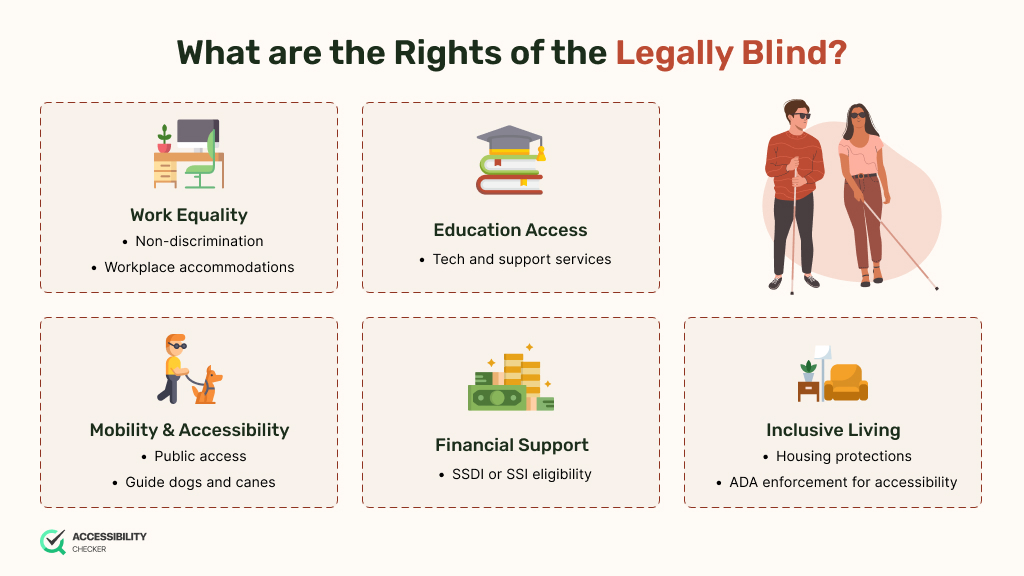Understanding Legally Blind: Definition and Causes
Fully understanding the term ‘legally blind’ makes it easier to comply with legal disability requirements as a business or determine whether you may be eligible for disability benefits.
We’ve created this comprehensive guide to give you all the information you need about legal blindness, how it’s diagnosed, and the tools that are available to ensure a better quality of life.

What Is Legally Blind?
Legal blindness is based on visual acuity, which is the sharpness of your vision, and visual field, which is the scope of what you can see without moving your eyes.
The term “legally blind” can apply to individuals who are totally blind as well as those with visual limitations that impact their daily lives.
Legal blindness definitions are generally the same across all states in the United States; however, there are some differences when it comes to how ‘“low vision” is defined.
Let’s get into some further details on low blindness criteria.
Visual Acuity
Vision is normally measured as 20/20, which means visual acuity determines how close someone would need to be to an object that’s 20 feet away in order to see it.
Let’s say a person had visual acuity of 20/60. This means they can see details from 20 feet away in the same way someone with 20/20 vision could see it from 60 feet away.
A visual acuity of 20/40 or worse, even with corrective lenses, is seen as low vision. 20/200 vision is seen as legally blind.
Visual Field
A normal visual field is 180 degrees. This means someone can see clearly without having to move their eyes, aka they have peripheral vision.
On the other hand, a person with a visual field of 20 degrees can only see what’s in front of them without moving their eyes. This visual limitation, also known as tunnel vision, can make it difficult to engage in daily activities such as driving.
What Is It Like to Live with Legally Blind Vision?
Legal blindness is slightly different for everyone because it varies in severity. One person may not be able to see at all, while another can see what’s right in front of them but not around them.
When you are diagnosed with legal blindness, you are unable to drive in America. You may also need specialized lenses and other assistive tools to perform day-to-day activities such as reading and walking.
Even though legal blindness has its limitations, it doesn’t prevent someone from leading a fulfilling life. Support is readily available to the legally blind community through organizations such as the American Foundation for the Blind (1). There are also laws, such as the ADA, that encourage inclusivity through specific legal standards and requirements.
Digital accessibility is an integral part of the ADA, which means businesses are required to make their websites and any other digital content accessible to people with disabilities, including those with visual impairments.
Testing for Legal Blindness
An optometrist or ophthalmologist has several tests they can perform to diagnose legal blindness. They can also determine whether wearing glasses or contact lenses can improve vision.
Most tests involve a chart, with the Snellen, tumbling E, and Jaeger eye chart being the most common. Someone who is legally blind would not be able to read the top line of any of these charts, even when wearing corrective lenses.
Other tests measure vision between 20/200 and 20/100. Anyone who tests within this range is considered legally blind in the United States.
To test a person’s visual field, a confrontational visual field test is used. A doctor covers one eye at a time and holds one or two fingers up in different quadrants of the visual field. The patient would need to indicate when they can see their doctor’s fingers while looking straight ahead.
Some doctors also make use of computerized tests that mainly incorporate flickering or flashing lights to test the visual field of a patient.
Low Vision vs. Legal Blindness
Someone with low vision still has some sight, but daily activities such as driving and reading could prove difficult. A person with low vision may not be able to see objects that are far away or be able to differentiate between certain colors – color blindness is an example of this.
A person who is legally blind will need to be really close to an object to see it and may only see light and dark images. And, in some instances, they may not be able to see at all. Legally blind individuals will generally rely on mobility aids and assistive technology to get through their day.
The Rights of the Legally Blind
Legally blind individuals may be able to receive grants through the government and other disability organizations. The Social Security Administration (SSA) is one of the main programs.
The SSA has two programs available that can benefit people living with visual impairments and blindness, namely the Social Security Disability Insurance program and the Supplemental Security Income program.
Receiving a grant from either of these programs is not guaranteed, though, as they assess people on a case-by-case basis. You can read more about the program requirements on the SSA site (2).
Aids and Assistive Technology for the Legally Blind
There are a number of aids and types of assistive technology available to the legally blind community.
- Service Dogs. Service dogs are specifically trained to guide blind people in their day-to-day lives. They can also be trained to pick things up and remind you about medication. Service dogs are permitted in public spaces, including restaurants and airplanes.
- Canes. Canes are another popular mobility aid, ensuring those with blindness and low vision can get around with more confidence.
- Ultrasonic Mobility Aids. These specialized aids use ultrasonic waves to alert people to obstacles in front of them. They are often used in conjunction with canes and service dogs. UltraCane and the Ray electronic mobility aid are two examples of this.
- Screen Readers. This is one of the tools that is used most often by legally blind people. Screen readers such as OrCam MyEye Pro 3 scan text on a screen and read it back to someone. This is where web accessibility becomes really important. A site that is not created with accessibility in mind won’t be compatible with screen readers and would exclude a visitor with visual impairments.
- Text-to-Speech Software. This software is designed to scan printed text and read it out loud to the user. Text-to-speech software is often used by students and learning institutions, ensuring everyone has access to education.
- Refreshable Braille Displays. By processing information on a computer, these devices raise or lower pins in braille cells, making it possible for a legally blind person to read what’s on screen. The pins change as a user moves their cursor around a screen.
Conclusion
With over 7 million people in the USA living with some form of visual impairment, it’s imperative to understand what legal blindness is and what can be done to promote inclusivity. Fortunately, there are already a number of organizations doing their part to improve the lives of the legally blind community. The ADA and other global disability acts are also making a noticeable difference in how the world views disabilities.
Legal Blindness FAQs
A person with 20/80 is able to see the details of an object close up. However, the further they move away, the more clarity and sharpness fade. They may also struggle to focus when they’re in a group of people or when there isn’t enough light. A 20/80 vision profile is commonly referred to as nearsightedness.
A legally blind prescription is anything that’s lower than -2.5, which is the equivalent of 20/200 vision. Visual acuity is directly linked to a prescription level. So, for example, visual acuity of -4.0 means you have 20/400 vision.


